Tours to Bhutan, Travel to Bhutan
- Bhutan Visitor Info
- Western Region Bhutan -
- Central Region Bhutan -
- Eastern Region Bhutan -
- Festivals of Bhutan -
- National symbols -
- History of Bhutan -
- Culture of Bhutan -
- Religion of Bhutan -
- People of Bhutan -
- Bhutan Visa & Customs -
- Bhutan Accommodation -
- Bhutan Transportation -
- Climate of Bhutan -
- Currency of Bhutan -
- Paro Festival Bhutan -
- Trekking in Bhutan -
Paro Festival - Bhutan
For further Details Contact Us
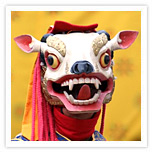 Introduction
Introduction
The tshechu is a festival in honour of Padmasambhava-"one who was born from a lotus flower ", popularly known under the name of " Guru Rimpoche " the Precious Teacher. This Indian saint contributed enormously to the diffusion of TantricBuddhism in the Himalayan region of Tibet, Nepal, and Bhutan etc. around 800 A.D He is the founder of Nyingmapa, the "old School "of Lamaism which still has numerous followers. The biography of Guru Rimpoche is highlighted by 12 episodes on the model of the Buddha Shakyamuni's life. Each episode is commemorated around the year on the 10th day of the month by "the Tshechu "which has become the name of a very popular festival. The dates and the duration of the festival vary from one district to another but they always take a place on or around the 10th day of the month according to the Bhutanese calendar.
During Tshechu the dances are performed by monks as well as by laymen. The Tshechu is a religious festival and by attending it, it is believed one gains merits. It is also a yearly social gathering where the people come together to rejoice dressed in all their finery.
The Thimphu Tshechu was established by the 4th Temporal Ruler, Tenzing Rabgye (1638-1696) in 1670 on the 8th month of the Bhutanese calendar to commemorate the birth of Guru Rimpoche.
Meaning and History of the Thanka in Paro
Buddhas and Bodhisattvas posse's indiscernible virtues which permit them to liberate from sufferings even those who fall straight into hell after having committed such sins as killing parents and breaking the vow to their clerical brothers and lamas.
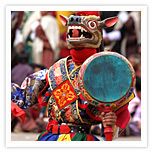
There, people have only to think, to touch, to taste, to smell, to listen and to see the support of body( i.e. statue), speech (book) and mind (i.e. chorten) of the Buddha and Bodhisattvas.
This is call liberation by the mind, by touch, by knowledge, by taste, by smell, by listening and by seeing.
The people who know virtuous and unvirtuous deeds, because of their devotion and faith in the support of body, speech and mind of the Buddha, have created the Thanka, a mere sight which liberates the individuals. In this mundane world there is nowhere to be found a more superior treasure.
In order to have all the sentient beings who are now a days impure, the Buddhas of ten direction have consulted each other and have united all their virtues of compassion resulting in the arrival of Ugyen Rinpoche on earth.
During a previous life, he was born as a son to a woman poultry farmer. At that time, while he was erecting the grate chorten of Jarungkhashor (Bodhanth in Nepal ), he made a powerful Vow to have compassion for sentient being particularly those of Nepal, Bhutan and Sikkim. As a result of his vow, he is giving compassion and blessing to them, for more rapidly than the other Buddhas.
This is why our accomplished forefathers made the great Thanka which represents Ugyen Rinpoche and his eight Manifestations, the sight of which liberates. They also established the code of veneration and offerings to it.
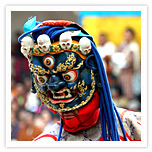
Both in this life and the next, it is hoped that those who have a great desire to be delivered from trnsmigratory existence develop and protect this excellent ancient costume.
Shugdrel Ceremony. (Blessing and offering ceremony performed by the monk body infornt of the Thanka). Regardless of the size of importance of any auspicious occasion, we must complete the Shugdrel Ceremony to show the main achievement of the glorious Drukpa.
Paro Tshechu
Day 1 (Inside the Dzong)
Dance of the Lord of Death and his Consort (Shinje Yab Yum)
Dance of Lords of Cremations Grounds ( Durdag )
Dance of Black Hats ( Shanag)
Dance of Drum from Dramistse (Dramitse Nacham)
Dance of Eight kinds of Spirits (Degye )
Religious Song (Chhoeshey)
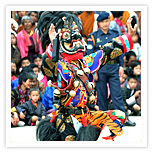
Day 2 (Outside the Dzong)
Dance of the Lord of Death and His Consort (Shinje Yab Yum)
Dance of Black Hats with Drums (Shanag Nga Cham)
Dance of three kinds of Ging with Sticks (Gynging)
Dance of Lord of Cremation Ground (Durdag)
Dance of three kinds of Ging with Drums (Driging)
Dance of three kinds of Ging with Drums (Ngaging)
Dance of Stage and the Hounds (Shawa Shachi) 1st part
Day 3
Dance of the Lords of the Cremation Grounds (Durdag)
Dance of Terrifying Deities (Tungam)
Dance of Heroes with six kinds of Ornaments (Guan Drug Pawo) Kyacham
Dance of Novel man and Ladies Lencham
Dance of Stag and Hounds (2nd part) (Shawa Shacha)
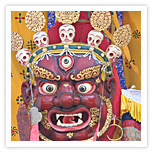
Day 4
Dance of Lord of Death and His Consort (Shinje Yab Yum,)
Dance of four Stags (Sha Tsam)
Dance of Judgement of the Dead (Raksha Mangcham)
Dance of the Drums from Dramitse ( Dramitse Nga Cham)
Day 5
Early morning the great Thanka (Thongdrol) is shown and Shugdrel Ceremony is performed.
Dances of the Heroes (Pacham)
Dance of Ging and Tsholing
Dance of the Eight Manifestations of Guru Rinpoche (Guru Tshen Gye)
Dance of the Sixteen Fairies
Religious Song (Chhoeshey)






